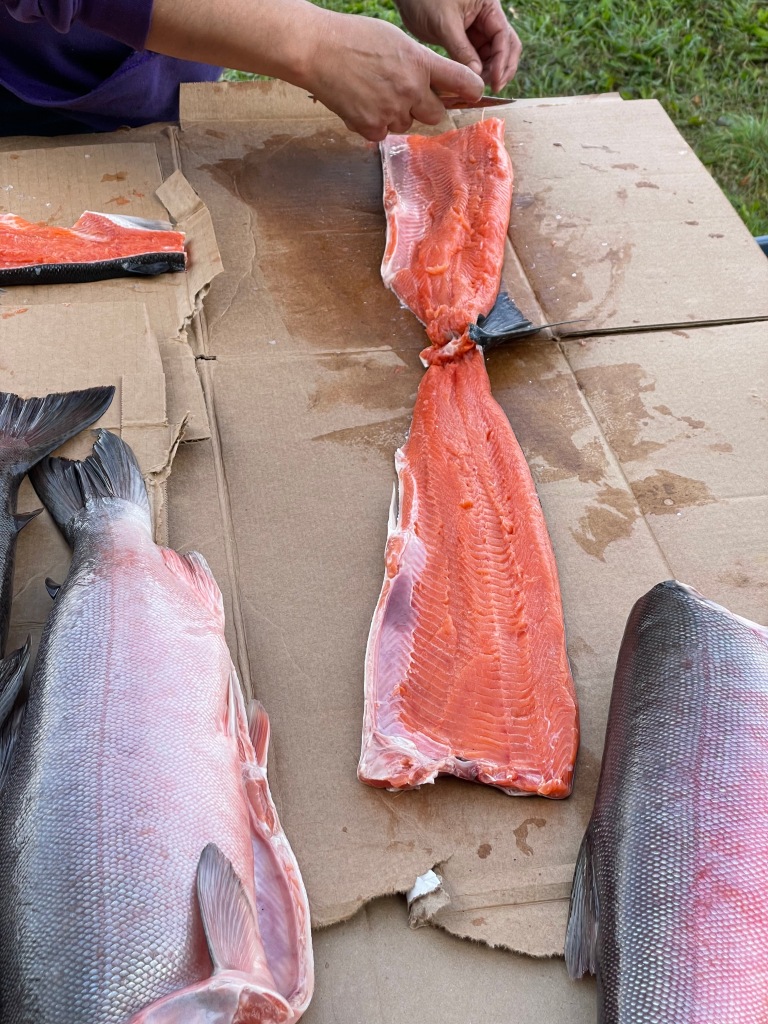Ahhhhh….the sweet smell of smoldering cottonwood filled the smokehouse. The end of summer was approaching and a local friend who grew up on the Yukon River was showing us how to cold smoke salmon using traditional indigenous ways. If you like salmon, this post is definitely for you!
It is fairly easy to prepare the fish and brine it for smoking. Gut the fish, chop the heads off, fillet the fish, slice the flesh and dip fillets in brine. The brine is a mix of salt, brown sugar and water. The real time, and patience, comes with the actual smoking part especially if you do a cold smoke verses a hot smoke. Cold smoking takes about 3 days to a week. This depends on how dried you want your salmon, how cold it is outside and whether or not you are going to further process the fish by canning following the smoke. Cold smoking is done at a very low temperature where not much heat is coming off the wood. You want the wood smoldering, very smoky and a “cough, cough” response from on lookers when you enter the smoke house.


All set to fillet 
Cut fish 
Cutting the slices into the salmon flesh. 

Cut and sliced fish ready to be brined. 
Brining the fish. 
Brine dipped salmon. 
Hanging the rack in the smokehouse. 
Silvers hanging in the smokehouse and ready for smoking.
A hot smoke is done with more heat. It’s a faster process, taking around 8 hours to completion depending on the heat of the smoker, temperature outside and thickness and size of the salmon pieces. It can be done with wood or more commonly in today’s era, by using an electric smoker. Lots of options exist for wood chip flavors- alder, maple, hickory, cherry, or whatever wood type is locally available that puts off a tasty aromatic smoky air. The salmon comes out differently depending on which method you select. Hot smoked fish has a different texture-it is more flakey and less “jerked” in structure. A person needs patience while waiting for fish to cold smoke, but once you’ve tasted it you’ll discover it is well worth the wait.
Items for cold smoking salmon include: water, a tub or bucket, cardboard, brown sugar, salt, knives, brine materials, and green, fresh cut wood for the smoke. Our wood was very fresh- our friend’s son cut a cottonwood tree down right in their yard while we cut and prepped the fish! I like using my ulu knife, pictured below, for cutting fish but any fillet knife will do. The ulu below was made by a Yupik Eskimo friend of mine from Goodnews Bay. He cut the metal blade out from an old hand saw and attached a bone hand-carved handle.


Of course, salmon are needed as well. We caught these silver salmon in August on the Kuskokwim River. They aren’t super fresh right out of the ocean but were in good shape for upriver fish. This batch took us 3 days to smoke and we ended up processing it in a pressure canner in pint and half pint jars. Gratefully, our friend’s son kept the smoke going for those 3 days so we didn’t have to keep checking the smokehouse. It is SO scrumptious! I can barely wait until next summer to do it again.



Over the years, we have eaten salmon in so many different ways: baked, grilled, pickled, fried, sauteed, poached, and smoked. You name it, we’ve had it. I’ve even eaten it off a stick called “fish on a stick” for obvious reasons. This was the most memorable way I’ve ever eaten salmon.
Years back soon after coming to Alaska, we worked on several river systems in Togiak National Wildlife Refuge which had bountiful salmon runs. As river rangers, we patrolled the rivers in flat bottom aluminum skiffs equipped with 40 hp Yamaha engines with jet units. The rivers were shallow, clear, cold and stunningly beautiful. On one foray, we were miles from camp when hunger pained down upon our stomachs. The pilot bread and peanut butter sandwiches stowed in our lunch bag weren’t real appealing to us, especially after eating them for lunch for weeks on end.
A colleague suggested we catch and cook a salmon. I explained we had no fillet knife and zero cooking utensils. For those who have lived off the land this was a ridiculous statement as I quickly learned. Who needs anything? We would just make due with what we had. We caught a salmon, gutted it with a little Leatherman knife, skewered it with a cut tree branch and cooked if over a small wood fire. Eaten with bare hands (recall we had no utensils), without a plate (didn’t have those either), and while sitting on the ground watching the river go by, it was an experience that brought a person in close with the living nature that surrounds us in remote Alaska. A true Alaska style barbeque of delicately cooked salmon flaking off in tantalizingly moist chunks.
I was not able to dig up any images of that day in the Refuge, but here are some photos of a float trip taken in Togiak Nat’l Wildlife Refuge years ago.



